“We’re afraid to talk about Gaza”
Joaquin Phoenix calls Gaza situation “horrible” and questions new aid methods over trusted distribution channels.
Source link
Stay informed and up-to-date with the latest news from around the world. Our comprehensive news coverage brings you the most relevant and impactful stories in politics, business, technology, entertainment, and more.
Joaquin Phoenix calls Gaza situation “horrible” and questions new aid methods over trusted distribution channels.
Source link
Gaza’s health ministry says 18 people have starved to death in the last 72-hours, including four children. Experts say the famine is predictable and planned. This is how some people are trying to stay alive.
Published On 21 Jul 202521 Jul 2025
A body has been found in a lake during a search for a missing mother.
Rachel Booth, 38, disappeared in the early hours of Saturday after she was last seen by her family in the village of Barnton in Cheshire.
Cheshire Police earlier said officers had found a body which they believed to be Ms Booth in a lake in Oakmere after “extensive searches and appeals in the area”.
The body has not been formally identified but Ms Booth’s family has been informed and was being supported, the force said.
Police said there were not believed to be any suspicious circumstances and report would be prepared for the coroner.
After she disappeared, CCTV footage showed Ms Booth at Sandiway Garage of the A556 near Northwich at about 03:50 BST on Saturday.
Wild Shore Delamere, which offers outdoor activities at its lake nearby, had closed while the search commenced.
Barcelona agree deal to sign England international Marcus Rashford on an initial loan deal from Manchester United.
Barcelona’s already impressive front line is about to be boosted by the signing of Marcus Rashford.
Rashford is in Barcelona to complete a move from Manchester United, a person with knowledge of the transfer told The Associated Press news agency on Monday.
The person was not authorised to speak about the transfer publicly and did not want to be named.
The loan deal would give the 27-year-old England forward, once considered among Europe’s top talents, a chance to revive a career that has stalled in recent years after he fell out of favour at United and ended last season on loan at Aston Villa.
Spanish media said the one-year loan would give Barcelona an option to buy Rashford for about $35m.
Barcelona had the best attack in Spanish football and one of the most prolific across Europe last season but had been trying to add another piece to the front line to go along with young star Lamine Yamal, Raphinha and veteran Robert Lewandowski.
Rashford has spent his entire career at United, scoring 138 goals in 429 appearances and winning five major trophies, including two FA Cups and the Europa League.
But he struggled to consistently live up to the hype that surrounded him when he burst onto the scene as a teenager in 2016 – managing 20 goals or more only in three seasons. In his past two seasons at United, he scored a combined 15 goals and added another four in 17 games on loan at Villa.
Barcelona won the Spanish league title with 102 goals, 24 more than runners-up Real Madrid. The Catalan club also led the Champions League in goals with 43, five more than champion Paris Saint-Germain, before being eliminated by Inter Milan in the semifinals.
Bedouin families leave Druze-majority city after truce in the southern province halts bloody clashes between the communities.
The Syrian government is evacuating hundreds of Bedouin families trapped inside the southern city of Suwayda, where a fragile ceasefire is holding after Druze and Bedouin fighters fought for a week.
The first Bedouin families left on Monday on buses and trucks accompanied by Syrian Arab Red Crescent vehicles and ambulances. They were taken to nearby Daraa as the government plans to evacuate 1,500 people.
“At least 500 people have already left on 10 buses this morning, and more are expected to exit Suwayda in the next few hours,” Al Jazeera’s Mohamed Vall said about noon (09:00 GMT) on Monday in a report from the capital, Damascus.
The clashes between the Druze minority and Bedouin clans, which began on July 13, killed nearly 260 people and threatened to unravel Syria’s post-war transition. The violence also displaced 128,571 people, according to the United Nations International Organisation for Migration.
Israel intervened and launched air attacks on Syria’s Ministry of Defence buildings in the heart of Damascus. Israeli forces also hit Syrian government forces in Suwayda province, claiming it was protecting the Druze, whom it calls its “brothers”.
Vall said some Bedouin families were evacuating the province voluntarily.
“There are seven districts of Suwayda that are inhabited partly or … mostly by Arab Bedouins, and they are all under threat – or they feel under threat – and some of them are willing to leave [on their own],” he said.
Syrian Interior Minister Ahmad al-Dalati told the SANA news agency that the evacuation process will also allow displaced civilians from Suwayda to return as efforts for a complete ceasefire are under way.
“We have imposed a security cordon in the vicinity of Suwayda to keep it secure and to stop the fighting there,” al-Dalati told the agency. “This will preserve the path that will lead to reconciliation and stability in the province.”

According to the United Kingdom-based Syrian Observatory for Human Rights war monitor, the ceasefire agreed on Saturday says the Bedouin fighters will release Druze women they are holding captive and leave the province.
After talks for a captives swap fell through late on Sunday, the observatory and activist groups in Suwayda reported hearing what they said were Israeli air strikes and helicopters over villages where some skirmishes took place between the Bedouins and the Druze.
The Israeli military said it was “not aware” of any overnight strikes in Syria.
Meanwhile, an initial Syrian Arab Red Crescent convoy entered Suwayda on Sunday, carrying UN humanitarian assistance, including food, water, medical supplies and fuel, the UN Office for the Coordination of Humanitarian Affairs said.
Interim Syrian President Ahmed al-Sharaa has tried to appeal to the Druze community while slamming its factions loyal to spiritual leader Sheikh Hikmat al-Hijri who have been involved in the clashes. He promised to hold accountable perpetrators of targeted attacks and other violations.
The Druze minority largely celebrated the downfall in December of the al-Assad family, which ruled Syria for 53 years.
But al-Hijri, who had some allegiance to deposed President Bashar al-Assad in the past, and his supporters have taken a more confrontational approach with al-Sharaa, contrary to most other influential Druze figures.
Unification ministry in Seoul says allowing individual tours will not violate international sanctions.
South Korea is considering allowing individual tours to North Korea as it studies ways to improve relations with its neighbour, a spokesperson for South Korea’s Ministry of Unification says.
“The government is formulating and pursuing North Korea policies with the goal of easing tensions on the Korean Peninsula and improving inter-Korean ties with various measures under consideration in the process,” the ministry said in a statement on Monday.
The announcement was made as Seoul takes more steps to ease tensions with its northern rival after the election of President Lee Jae-myung, who has pledged to improve strained ties with Pyongyang.
In a bid to ease tensions, Lee suspended anti-North Korea loudspeaker broadcasts along the border and ordered a halt to leaflet campaigns criticising the North’s leaders by anti-Pyongyang activists.
Koo Byung-sam, spokesperson for the Unification Ministry, which handles inter-Korean affairs, refused to comment on a “particular issue”. But he said he understood individual tours were not in violation of international sanctions, according to a report by the Reuters news agency.
South Korea’s Dong-A Ilbo newspaper also said Lee’s administration is considering resuming individual trips to North Korea as a negotiating card to reopen dialogue with Pyongyang.
It reported that Lee mentioned the proposal during a National Security Council meeting on July 10. The government subsequently began a review of the plan, the report added, quoting a senior official.
Tourism is one of a narrow range of cash sources for North Korea that are not targeted under United Nations sanctions imposed over its nuclear and weapons programmes.
Citing anti-Pyongyang broadcasters, South Korea’s Yonhap News Agency also reported on Monday that the National Intelligence Service this month had suspended all of its decades-old broadcasts targeting the North Korean regime.
Lee said he will discuss further plans with top security officials to resume dialogue with North Korea, which technically is still at war with the South after the 1950-1953 Korean War ended with an armistice and not a peace treaty.
North Korea recently opened a beach resort in the city of Wonsan, a flagship project driven by leader Kim Jong Un to promote tourism. But the tourist area is temporarily not accepting foreign visitors, according to a note on Wednesday by DPR Korea Tour, a website operated by North Korea’s National Tourism Administration.
North Korea’s tourism industry appears to be struggling even after it lifted COVID-19 border restrictions, allowing rail and flight services with Russia and China.
Asked if South Koreans would travel to Wonsan, Koo said North Korea first needs to open the area to the outside world.
South Korea once ran tours to North Korea’s Mount Kumgang area but suspended them in 2008 when a South Korean tourist was shot dead by a North Korean soldier.
Tokyo correspondent

 Reuters
ReutersFor three years, a once fringe opposition party held just one seat in Japan’s 248-seat upper house.
But on Sunday, Sanseito emerged as one of the biggest winners of Japan’s election – walking away with 14 seats.
The party was born in 2020 during the Covid-19 pandemic, where it gained prominence with YouTube videos that spread conspiracy theories about vaccinations.
More recently, it has built its platform on a nationalist “Japanese First” agenda, warning against a “silent invasion of foreigners”.
Sanseito’s rise in popularity reflects growing unease over immigration and overtourism – issues the ruling government also sought to address with a new committee it created days before the election.
But do these gains signal an enduring shift to the right in Japan?
Launching in early 2020, Sanseito gained attention among conservatives with its series of YouTube videos centred on anti-vaccine and anti-masking rhetoric.
It won its first seat in the upper house in 2022, following a campaign in which it fashioned itself as an “anti-globalist” party. Supporters at rallies spoke of a world where a cabal of globalists and financial institutions were conspiring to lord over powerless citizens.
In its recent campaign, the party made populist pledges such as consumption tax cuts and an increase in child benefits. But it’s been most well known for its nationalist “Japanese First” platform rallying against immigrants, with its leader Sohei Kamiya previously saying that he had drawn inspiration from US President Donald Trump’s “bold political style”.
Sanseito’s promises have won it the support of young conservatives online – cutting into the ruling Liberal Democratic Party’s (LDP) conservative support base.
The weekend’s election result also underscores voters’ frustration with the LDP’s leader and Prime Minister Shigeru Ishiba, who has struggled to inspire confidence as Japan struggles against economic headwinds, a cost-of-living crisis and trade negotiations with the United States.
Jeffrey Hall, a lecturer in Japanese Studies at Kanda University of International Studies, says support for more right-wing parties had drawn conservative voters away from the LDP.
“Prime Minister Ishiba is considered not conservative enough by many supporters of the former Prime Minister [Shinzo] Abe,” he says. “They think that he just doesn’t have the nationalistic views on history, he doesn’t have the strong views against China that Abe had.”
Instead, voters are turning to Sanseito and other opposition parties to “vent their frustrations and show the LDP they will pay for turning away from the conservative ideals the party once stood for”, says Rintaro Nishimura, an associate at The Asia Group’s Japan Practice – naming the bill that was passed under Kishida to promote LGBTQ awareness as an example.
“The success of [opposition parties in] this cycle shows that voters are sick of the status quo establishment politics,” he says.
This was also shown in the votes for another small opposition party, the centre right Democratic Party For People, who won 16 seats in Sunday’s election – a big jump from its previous 5 seats.
But for Sanseito, despite its gains this election, it still falls short of the minimum number of seats required to submit budget bills in the upper house. And in the more powerful lower house, it holds just three seats.
Kamiya, 47, was at one point of his political career a member of the long-ruling LDP. During the 2012 general election, the party’s then-president Shinzo Abe personally campaigned on his behalf – though he eventually lost the race.
Kamiya launched Sanseito in March 2020, and was the party’s only candidate to be elected into the upper chamber in 2022.
The former Self-Defence Force reservist has openly credited Trump for shaping his approach, and has railed against the political and financial elite.
Like the US president, Kamiya drew attention with his “often inflammatory and controversial remarks” on the campaign trail, says Mr Nishimura.
“His comments were spread across social media in a very well coordinated campaign,” he says.
“Under globalism, multinational companies have changed Japan’s policies for their own purposes,” Kamiya said at a recent rally in Kagoshima. “If we fail to resist this foreign pressure, Japan will become a colony!”
Earlier this year, he faced backlash after calling gender equality policies a mistake, saying they would encourage women to work and prevent them from having more children.
When asked about the party’s appeal to men, he said it might be due to him being “hot-blooded”, claiming “that resonates more with men”.
However, Mr Nishimura says that exit polls have showed that Sanseito’s support did not come necessarily from just younger men, but that they received consistent support from across the working population, or those aged between 20 to 50.
There was a slant towards male voters, but not “disproportionately so”, added Mr Nishimura.
Following Sunday’s election, Kamiya vowed to secure “50 to 60 seats” in future elections so that “[the party’s] policies will finally become reality”.
He also appeared to try to walk back some of his earlier statements, clarifying in an interview with Nippon TV after the vote that his nationalist policy was not meant to “completely ban foreigners”.
The number of foreign residents in Japan hit a record 3.8 million at the end of 2024. That figure marks an increase up 10.5% from the previous year, according to immigration authorities – but still makes up just 3% of the country’s total population.
Tourist numbers also hit an all-time high of about 36.9 million last year, according to the National Tourism Organisation.
Sanseito has seized on the growing unease over immigration, blaming the ruling LDP for policies that have allowed more foreigners into the country.
Anti-immigration rhetoric often surfaces in countries dealing with a weakening economy, says Mr Hall.
“Misbehaviour and bad manners by some tourists” have added fuel to the fire, creating an impression of a “big foreign problem”, he adds.
“[Sanseito] tapped into the frustration over immigration and the perhaps unwarranted feeling that immigrants were rising too much in number,” he says.
Japan has traditionally been wary of immigration, but faced with an ageing population, the government had eased immigration laws in recent years in an effort to boost manpower.
Some Japanese people have been frustrated by the influx of foreigners and have blamed them for rising crime and inflation, among other things.
On Tuesday, less than a week before the election, authorities set up a new committee aimed at easing citizens’ concerns, pledging to shape a “society of orderly and harmonious coexistence with foreign nationals.”
But it now appears to have come too late – and Sanseito’s ascent may signal a turning point in Japan’s political landscape.
“I think for years now, people said Japan doesn’t have a populist right, or doesn’t have a populist far right,” says Mr Hall. “But I think [the result] has proven that there is a possibility for this to happen in Japan, and it’s probably here to stay.”
However, Mr Nishimura notes that it has been “notoriously hard” for populist parties to firmly establish themselves as a presence in Japanese politics because of the “fickle” electorate.
“If they see that a party they supported isn’t living up to their expectations, they will revert to the established choices or move onto newer alternatives.”
Adolfo Macias, who was recaptured in June after escaping from a prison last year, will appear in a New York state court on Monday.
Ecuadorean gang leader Adolfo Macias Villamar, also known as “Fito”, is set to appear in a federal court in the United States, where he will plead not guilty to international charges of drug and weapons trafficking, his lawyer says.
The Ecuadorean government on Sunday extradited the notorious drug trafficker, a month after he was recaptured following a 2024 escape from a maximum-security penitentiary, the country’s prison authority said.
Macias, the leader of the Los Choneros gang, was serving a 34-year sentence at a prison in Guayaquil for a slew of crimes, including drug trafficking, organised crime, and murder.
The flight transporting Macias landed in New York state on Sunday night, the report said. His lawyer told the Reuters news agency that Macias “will plead not guilty” before the Brooklyn federal court on Monday.
Details of the handover to the US government and the extradition were not specified. The US government has yet to issue an official statement following the extradition.
The US Attorney’s Office had filed charges in April against Macias on suspicion of cocaine distribution, conspiracy and firearms violations, including weapons smuggling.
The former taxi driver turned crime boss agreed in a Quito court last week to be extradited to the US to face the charges.
He is the first Ecuadorean extradited by his country since a new measure was written into law last year, after a referendum in which President Daniel Noboa sought the approval of moves to boost his war on criminal gangs.
Ecuador, once a peaceful haven between the world’s two top cocaine exporters, Colombia and Peru, has seen violence erupt in recent years as rival gangs with ties to Mexican and Colombian cartels vie for control.
Soon after Macias escaped from prison in January 2024, Noboa declared Ecuador to be in a state of “internal armed conflict” and ordered the military and tanks into the streets to “neutralise” the gangs. The move has been criticised by human rights organisations.
As a drug lord, Macias cultivated a cult status among fellow gang members and the public.
While behind bars in 2023, he released a video addressed to “the Ecuadorian people” while flanked by armed men. He also threw parties in prison, where he had access to everything from liquor to roosters for cockfighting matches.
Macias’s Los Choneros has ties to Mexico’s Sinaloa cartel, Colombia’s Gulf Clan, which is considered the world’s largest cocaine exporter, as well as Balkan mafias, according to the Ecuadorian Organised Crime Observatory.
His escape from prison prompted widespread violence and a massive military and police recapture operation, including government “wanted” posters offering $1m for information leading to his arrest.
On June 25, Macias was found hiding in a bunker concealed under floor tiles in a luxury home in the fishing port of Manta, the centre of operations for Los Choneros. Noboa declared he would be extradited, “the sooner the better”.
“We will gladly send him and let him answer to the North American law,” Noboa told CNN at the time.
More than 70 percent of all cocaine produced in the world now passes through Ecuador’s ports, according to government data. In 2024, the country seized a record 294 tonnes of drugs, mainly cocaine.
BBC News, Yorkshire

 Getty Images
Getty ImagesA national inquiry will be held into one of the most violent days of the year-long miners’ strike in the 1980s, the government has announced.
The inquiry will look into the clash that involved police and miners outside the Orgreave coking plant in Rotherham on 18 June 1984.
The incident, which became known as the Battle of Orgreave, involved miners from across Britain converging on the plant to try to disrupt deliveries, but they were met with force by thousands of police officers.
Joe Rollin, from the Orgreave Truth and Justice Campaign, has been calling for an inquiry for 13 years. He said he was “cautiously elated” by the news.
Home Secretary Yvette Cooper, who announced the inquiry, said those affected by the confrontation had had “unanswered questions for over 40 years”.
She said the inquiry had been put “in our Labour manifesto last year and that’s what we’re now delivering”.

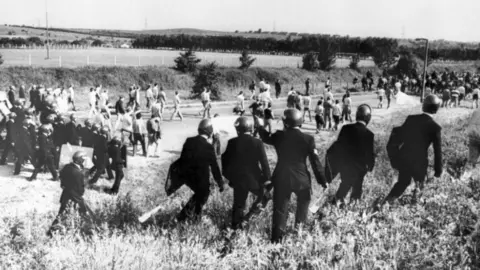 PA Media
PA MediaThe inquiry will be chaired by the Bishop of Sheffield, the Rt Rev Dr Pete Wilcox, and will look at both the events of the day and the aftermath, Ms Cooper said.
That will include the eventually failed criminal prosecutions of 95 miners and what Ms Cooper described as the “discredited evidence” against them.
The incident was sparked after the National Coal Board (NCB) announced in March 1984 that it was shutting 20 UK collieries it said were unprofitable.
This resulted in the loss of at least 20,000 jobs.
More than three quarters of the country’s 187,000 miners went on strike in response to the announcement.
On the day of the clashes in June, the striking miners wanted to stop lorries carrying coke to fuel the Scunthorpe steel furnaces as they thought disrupting production would help win their fight against the closures and job losses.

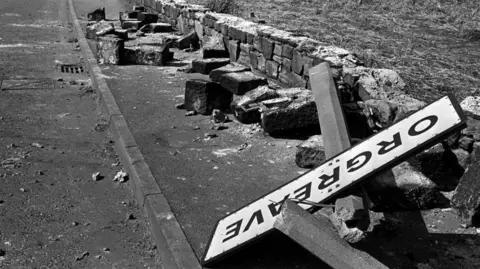 PA Media
PA MediaBut violent clashes between police and the miners left more than 100 picketers and officers injured at the coking plant.
A total of 95 men who had been picketing at the plant were arrested and faced trial on riot and unlawful assembly charges.
However, the case against them collapsed in court due to allegations that South Yorkshire Police had falsified evidence.
Many of those involved have said that even 40 years on, they want answers about what happened and why.
It is still considered one of the most violent episodes in British industrial history.
In 2016, the then home secretary, Amber Rudd, rejected calls for an inquiry into events at Orgreave, saying it would not be in the public interest.
She said even though miners who were involved gave “forceful accounts” about its lasting impact on them, “ultimately there were no deaths or wrongful convictions”.

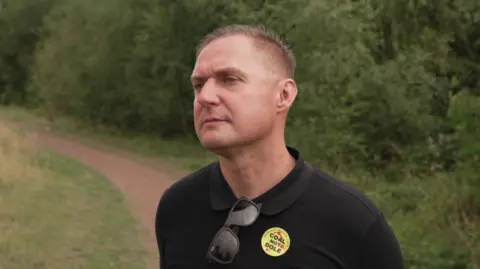
Mr Rollin said he and other members of the Truth and Justice Campaign were “really happy and we want to get to the truth”.
“It’s been a long slog these last 13 years and we can’t quite believe it,” he said.
“We want all the people who live around the country in mining communities that have been so badly treated to have a smile on their faces.
“This has been a hard-fought thing and thank you to everyone who’s supported us.”
Rotherham Labour MP Sarah Champion said former miners, their families and campaigners had worked “tirelessly” to secure an inquiry.
She said: “I have stood shoulder to shoulder with campaigners over the years as they were led to believe an inquiry was about to be commissioned, only to have the rug pulled out from under them.
“They have been let down time and time again, and I am proud that our Labour government is good to its word and will finally uncover the truth.”
South Yorkshire’s Mayor Oliver Coppard said the announcement of the inquiry was a “landmark moment for justice and accountability”.
“We owe it to the miners, their families, and our communities to ensure that the events of Orgreave are finally understood,” he said.
South Yorkshire Police said it would “fully cooperate with the inquiry in a bid to help those affected find answers”.
Jamie George, a titan of the 2017 tour in New Zealand, starts at hooker after he was drafted in from the England camp in Argentina.
Blair Kinghorn is back from injury and has been chosen in his favoured position at full-back.
Both wings are Scottish, with Darcy Graham, one of the many who have been called up as cover, on the right wing and Duhan van der Merwe on the left.
Fin Smith and Ben White are the half-backs, just as they were in the rout of AUNZ.
Pierre Schoeman and Finlay Bealham pack down either side of George in the front row, with James Ryan and Scott Cummings renewing a partnership that faced the Waratahs in game three in Australia.
Jac Morgan will start at blindside for the first time on tour, with Josh van der Flier and Henry Pollock making up the back row.
Ewan Ashman, Rory Sutherland, Tom Clarkson and the latest call-up, Gregor Brown, all fill the bench as coach Andy Farrell throws a protective blanket over his first-choice players. Mack Hansen, who has been battling injury, is not included.
The relevance of this game is limited given that so many of the 23 are firmly out of Farrell’s thinking for Saturday’s second Test.
There are points of interest, however.
Kinghorn might well be playing for a starting place given that Hugo Keenan was hit-and-miss in the first Test. Kinghorn is probably favourite to take over.
Might Farrell be a bench contender on Saturday if he performs well on Tuesday, maybe at the expense of Marcus Smith?
Garry Ringrose, who is fit again, was having a storming tour before getting concussed against the ACT Brumbies in Canberra.
Does Farrell dare to break up the Scottish midfield by picking Ringrose ahead of Huw Jones? If not, does he bring Ringrose on to the bench for Saturday ahead of countryman Bundee Aki?
The Lions back row performed wonderfully in Brisbane so it is impossible to see a change there, but what about the back-up?
It was Earl on Saturday and it might well be Earl again, but Morgan, having played at seven throughout the tour, is now being given a shot at six. He is fighting for a place in the 23.
Tuesday’s opponents will be captained by the veteran Kurtley Beale.
The fly-half is one of six indigenous players, with the rest of the squad made up of men with Pacific Islands heritage.
It is the first game of its kind, a celebration of First Nations, Samoan, Tongan, Fijian and Cook Island culture.
Tonga-born prop Taniela Tupou and Fiji-born wing Filipo Daugunu have been released from the Australia camp to play for a team coached by Australia 1999 World Cup winner Toutai Kefu.
BBC News, Essex
BBC News, Essex

 PA Media
PA MediaSix people have been arrested during the latest protest outside a hotel used to house asylum seekers in Essex.
Bottles and smoke flares were thrown towards police vehicles during the demonstration which saw more than 1,000 people gathered at the site of the Bell Hotel in Epping.
Ch Supt Simon Anslow said it was disappointing to see the protest escalate into “mindless thuggery”.
The disorder followed the arrest and charge of an asylum seeker last week on suspicion of alleged sexual assaults in the town.
“Our cells, which have been filling up throughout the evening, are ready for you,” Ch Supt Anslow warned in a statement.
“I think I speak for all of us – including the people of Epping – when I say we’ve had enough of your criminality,” he added.
Police put in place a Section 35 dispersal order to “prevent further crime or anti-social behaviour” overnight.
Demonstrators on Sunday chanted “send them home” and “save our kids”, as projectiles were thrown towards police vans blocking the entrance to the hotel.
Many had travelled from across the UK, with one woman from Scotland telling the BBC she felt compelled to “support local people and get the asylum seekers out”.
Police also surrounded a counter-protester, an elderly woman, before escorting her out of the area as masked protesters followed her and shouted abuse.

 PA Media
PA Media
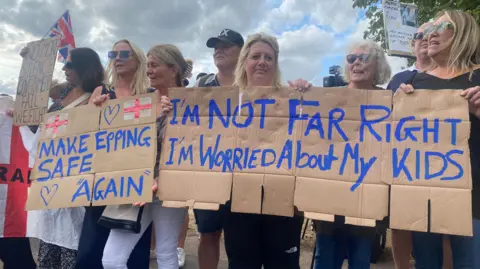 Greg McKenzie/BBC
Greg McKenzie/BBCUnrest at the site on Thursday led to three arrests after eight police officers were injured.
Plans for Sunday’s protest prompted Essex Police to announce a section 60AA order requiring the removal of face coverings until 04:00 on Monday.
One man was earlier charged with violent disorder and criminal damage following previous clashes outside the hotel.
A spokesperson for the force added: “We will deal robustly and quickly with anyone intent on coming into Epping to commit selfish criminal behaviour.
“The right to peaceful protest is protected by law and allows everyone freedom of expression, but this must be done respectfully and if there is a risk to public order we will act appropriately.”
The order is in place around Epping including its tube station.

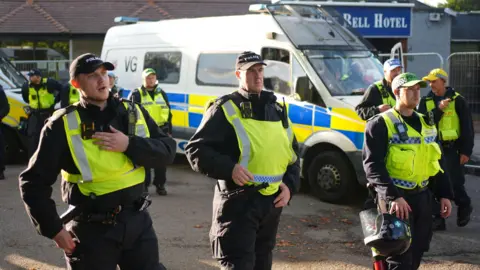 PA Media
PA MediaThursday’s demonstration was one of a series of protests outside the hotel since 38-year-old asylum seeker Hadush Gerberslasie Kebatu was charged with sexual assault – after an incident where he is alleged to have attempted to kiss a 14-year-old girl.
He denied the charge when he appeared at Chelmsford Magistrates’ Court on Thursday.







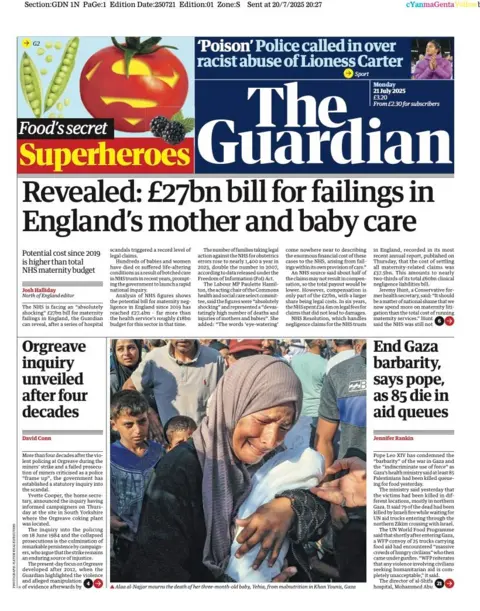


















BBC News, Toronto

 Canadian Press
Canadian PressMorgan Birch was puzzled when her four-month-old daughter, Kimie, suddenly fell ill with a fever and rash.
At first, the Alberta mother assumed it was a common side effect of immunisations – or perhaps a case of chicken pox. Ms Birch then consulted her 78-year-old grandmother, who recognised Kimie’s illness immediately.
“That’s measles,” her grandmother said. Ms Birch was stunned, as she thought the disease had been eradicated.
A lab test later confirmed her grandmother’s hypothesis: Kimie had measles, likely contracted after a routine visit to the hospital in the Edmonton area a few weeks earlier.
Kimie is one of more than 3,800 in Canada who have been infected with measles in 2025, most of them children and infants. That figure is nearly three times higher than the number of confirmed US cases, despite Canada’s far smaller population.
Now Canada is the only western country listed among the top 10 with measles outbreaks, according to CDC data, ranking at number eight. Alberta, the province at the epicentre of the current outbreak, has the highest per capita measles spread rate in North America.
The data raises questions on why the virus is spreading more rapidly in Canada than in the US, and whether Canadian health authorities are doing enough to contain it.
In the US, the rise of measles has been partly linked to vaccine-hesitant public figures, like Health Secretary Robert F Kennedy Jr – although he has since endorsed the measles vaccine as safe.
But Canada does not have a prominent RFK Jr-like figure in public health, noted Maxwell Smith, a postdoctoral fellow in public health at Western University in southern Ontario.
“There are other things that need to be interrogated here I think,” Dr Smith said. “Looking at the Canadian context adds another layer of complexity to this.”
Measles overall is on the rise in North America, Europe and the UK. Cases in the US reached a 33-year high this year, while England reported nearly 3,000 confirmed infections in 2024, its highest count since 2012.
Canada’s 2025 figures have surpassed both. The country has not seen this many measles cases since the illness was declared eliminated in 1998. Before this year, the last peak was in 2011, when about 750 cases were reported.
The MMR vaccine is the most effective way to fight off measles, a highly contagious and dangerous virus, which can lead to pneumonia, brain swelling and death. The jabs are 97% effective and also immunise against mumps and rubella.

 Morgan Birch
Morgan BirchThe hardest-hit provinces have been Ontario and Alberta, followed by Manitoba.
In Ontario, health authorities say the outbreak began in late 2024, when an individual contracted measles at a large Mennonite gathering in New Brunswick and then returned home.
Mennonites are a Christian group with roots in 16th-Century Germany and Holland, who have since settled in other parts of the world, including Canada, Mexico and the US.
Some live modern lifestyles, while conservative groups lead simpler lives, limiting the use of technology and relying on modern medicine only when necessary.
In Ontario, the illness primarily spread among Low German-speaking Mennonite communities in the province’s southwest, where vaccination rates have historically been lower due to some members’ religious or cultural beliefs against immunisation.
Almost all those infected were unvaccinated, according to data from Public Health Ontario.
Catalina Friesen, a healthcare worker at a mobile clinic serving the Mennonite population near Aylmer, Ontario, said she first became aware of the outbreak in February, when a woman and her five-year-old child came in with what appeared to be an ear infection. It later turned out to be a symptom of measles.
“This is the first time I’ve ever seen measles within our community,” Ms Friesen told the BBC.
Cases spread rapidly from that point, reaching a peak of more than 200 a week across Ontario by late April.
While new confirmed cases have since dropped sharply in Ontario, Alberta has emerged as the next hotspot. There, the spread happened so quickly that health officials were unable to pinpoint exactly how or where the outbreak began, said Dr Vivien Suttorp, the medical officer of health in southern Alberta, where cases are the highest.
She, too, said she had not seen an outbreak this bad in her 18 years working in public health.
Ms Friesen noted that Canada has a higher concentration of conservative Low German-speaking Mennonites than the US, which may be a factor behind the higher number of cases.
But Mennonites are not a monolith, she said, and many have embraced vaccinations. What’s changed is the rapid spread of anti-vaccine misinformation both in her community and beyond after the Covid-19 pandemic.
“There’s hearsay that immunisations are bad for you,” Ms Friesen said, or are “dangerous”.
This is amplified by a general distrust in the healthcare system, which she said has historically ostracised members of her community.
“We are sometimes put down or looked down upon because of our background,” she said, adding that she herself has experienced discrimination in hospitals based on assumptions about her beliefs.
Experts say it’s tough to pinpoint why measles have spread wider in Canada than in the US, but many agree that cases in both countries are likely underreported.
“The numbers that we have in Alberta are just the tip of the iceberg,” said Dr Suttorp.
But there is one big reason driving the outbreak: low vaccination rates, said Janna Shapiro, a postdoctoral fellow at the University of Toronto’s Centre for Vaccine Preventable Diseases.
Dr Shapiro said there is “an element of chance” at play, where a virus is introduced to a community by accident and spreads among those who are unprotected.
“The only thing that is going to stop an outbreak is getting those vaccination rates up,” she said. “If the public is not willing to get vaccinated, then it will continue until the virus can’t find anymore receptible hosts.”
In general, studies show that vaccine hesitancy has risen in Canada since the pandemic, and the data reflects that. In southern Alberta, for example, the number of MMR vaccines administered has dropped by nearly half from 2019 to 2024, according to provincial figures.
Covid-19 vaccine mandates were fiercely opposed by some during the pandemic, prompting the so-called “Freedom Convoy” protest in Ottawa where truckers gridlocked the city for two weeks in 2021.

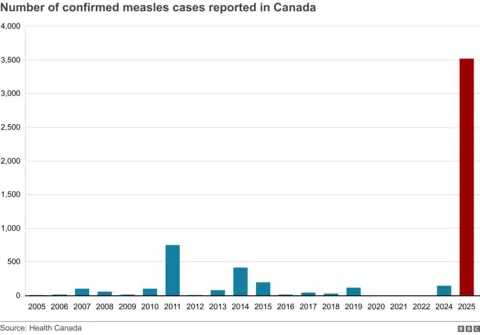
That opposition has since expanded to other vaccines, said Dr Shapiro.
Pandemic-related disruptions also left some children behind on routine immunisations. With measles having been largely eliminated, families likely did not prioritise getting their kids’ vaccinations up to date, Dr Shapiro said.
That is not the case for Ms Birch, who began routine immunisations for her baby Kimie as soon as she was eligible. But Kimie was still too young for the measles vaccine, which is typically given at 12 months in Alberta.
Dr Suttorp said Alberta has since lowered that age cap in response to the recent outbreak, and there has been an uptick in people taking the vaccine.
Health units across the country have also tried to encourage people to get vaccinated through public bulletins and radio advertisements. But the response is notably more muted than that during the Covid-19 pandemic, health officials say.
Kimie has since slowly recovered, Ms Birch said, though she continues to be monitored for potential long-term effects of the virus.
The Alberta mother said she was saddened and horrified when she learned her daughter had measles, but also “frustrated and annoyed” at those choosing not to vaccinate their children.
She called on people to heed public health guidelines and “protect the ones that can’t protect themselves”.
“My four-month-old shouldn’t have gotten measles in 2025,” Ms Birch said.
Here are the key events on day 1,243 of Russia’s war on Ukraine.
Here is how things stand on Monday, July 21:
Business reporter

 Getty Images
Getty ImagesPeople retiring in 2050 will be worse off than pensioners today, the government has warned, unless action is taken to boost retirement savings.
The Department for Work and Pensions (DWP) is reviving the Pensions Commission, which first reported nearly 20 years ago, to look at how to tackle the issue.
Almost half of working-age adults are not putting any money into a private pension at all, with low earners and the self-employed less likely to be pension saving, the DWP said.
The shortfall is also worse among women and some ethnic groups, with only one-in-four people of Pakistani or Bangladeshi background saving in a private pension.
People drawing their pension 25 years from now are set to be £800 or 8% worse off per year than their counterparts today, the department said, with four in 10 people currently not saving enough for their retirement.
Rather than launching a new commission from scratch, the government said it was reviving the “landmark” Turner Pension Commission which reported in 2006, under the last Labour government, and led to the roll-out of automatic enrolment into pension saving. As a result 88% of eligible employees are now saving, up from 55% in 2012, the DWP said.
Despite that progress, the DWP said new analysis revealed “stark” findings including that:
The analysis also found a 48% gender gap in private pension wealth among people currently retiring, with a typical woman receiving just over £100 a week and a man receiving £200 from private pension income.
The commission is not designed to directly address issues around the cost of the state pension.
Recent reports have raised questions over the affordability of the “triple lock”, introduced in 2010, which guarantees that state pensions will rise every year by the same amount as average wages, inflation, or 2.5%, whichever is higher.
As the population ages, and people live longer, the cost of that policy is set to grow significantly.
Its cost is forecast to be three times higher by the end of the decade than was original estimated, after successive years of high inflation, followed by strong wage growth.
Instead, the relaunched Commission, which will report in 2027, will look at savings in private sector pensions.
It will bring together trades unions, employers and independent experts, some of whom also took part in the original Commission. It will look at what is preventing people from putting more into their retirement pots and will aim to build a national consensus around future strategy.
Kate Smith, head of pensions at pension firm Aegon, urged the Commission to make “bold, brave and possibly unpalatable recommendations”, including “significant increases” to auto-enrolment contributions after 2029.
Paul Nowak, General Secretary of the Trades Union Congress described it as “a vital step forward”.
“Everyone deserves dignity and security in retirement, but right now many workers – especially those in the private sector – will find themselves without enough to get by on,” he said.
Caroline Abrahams, charity director of Age UK said that while the state pension provided the bulk of income for most pensioners, it was “hugely important” to consider the role of private savings, as the current system was leaving many pensioners struggling to make ends meet.
“Hopefully this can be avoided in future and particularly disadvantaged groups, including low-paid women and self-employed people on low incomes, can be helped to put money aside when appropriate for them to do so,” she said.
Catherine Foot, director of the think tank Standard Life Centre for the Future of Retirement, said that 17 million people were not saving enough to achieve the retirement they wished to have.
“The next two decades is when the effects of the savings crisis will really start to bite,” she said.
It was crucial that the Commission was able to take a step back and view the system in its entirety,” she added.
“There’s an opportunity to examine how different elements of the system are working together.”
Music Correspondent

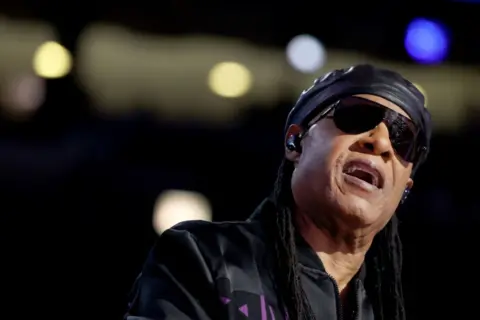 Getty Images
Getty ImagesAt the age of 75, Stevie Wonder is still going strong.
His latest UK tour, which wrapped up earlier this month received rapturous reviews, with critics calling the star “fresh and on form” for “a riotously joyful celebration” of his music.
But while contemporaries like Billy Joel and The Eagles are reducing their musical commitments, Wonder says he will never consider retiring.
“For as long as you breathe, for as long as your heart beats, there’s more for you to do,” the Motown legend told the BBC’s Sidetracked podcast. “I’m not gonna stop the gift that keeps pouring through my body.
“I love doing what I’m doing. An artist never stops drawing. As long as you can imagine is as long as you are going to be creative.”
The star also confirmed he was still working on a new album, titled Through The Eyes Of Wonder, which he first discussed in 2008.
The project has previously been described as a performance piece that will reflect his experience as a blind man.
It would be his first studio album since 2005’s A Time To Love; extending a recording career that started in 1962, when he was just 11 years old.

 Getty Images
Getty ImagesWonder spoke to Sidetracked presenter Annie Macmanus, the day before he headlined the BST festival in London’s Hyde Park – playing a two-and-a-half hour set that encompassed his biggest hits, from Superstition and Isn’t She Lovely to You Are The Sunshine Of My Life and I Wish.
Most of the set was drawn from the 1970s purple patch when he won the Grammy Award for best album three times in a row, for Innervisions, Fulfillingness’ First Finale and Songs In The Key Of Life.
Wonder told Macmanus that he never tired of revisiting those records.
“Songs are like children, they’re with you forever,” he said. “They are statement from the spirit within you.
“And singing those songs is like me taking another breath.”
Earlier this month, during a concert in Cardiff, the musician addressed a long-standing conspiracy theory that he is not actually blind.
“You know there have been rumours about me seeing and all that?” he told the audience, “But seriously, you know the truth.”
“Truth is, shortly after my birth, I became blind,” he told fans.
Calling his disability a gift, Wonder continued: “Now, that was a blessing because it’s allowed me to see the world in the vision of truth, of sight.”
In his Sidetracked interview, the singer talked about the importance of using music to spread positivity and speak truth to power.
Throughout his life, he has been a vocal civil rights campaigner, and played a key role in the campaign to have the birthday of Martin Luther King Jr recognised as a national holiday in the US.
Wonder, who campaigned for Democrat Kamala Harris in last year’s US presidential election, told Macmanus that America was currently beleaguered by “people trying to go backwards”.
“It’s not gonna go down like that,” he insisted. “I think that if you look back in history, there’s always been a point when people wake up.
“And I think that, for those who think it is gonna go down like that, remember that God is watching you.”
You can listen to Stevie Wonder’s full interview on the Sidetracked podcast on BBC Sounds.
Goals scored: Five Goals conceded: Five Wins: Three Best Euros performance: Runners-up, 1993 and 1997
Chance of winning Euro 2025 (Opta): 8.9%
Italy are the lowest-ranked team left in the tournament at 13th in the Fifa rankings, but after their impressive performance against Norway in the last eight it would be foolish to underestimate them.
They failed to qualify for four successive World Cups between 2003 and 2015 and have flown under the radar in Switzerland to reach a first European semi-final since 1997.
Progressing behind Spain in Group B they were the underdogs heading into the quarter-final against two-time European champions Norway, but they impressed with their pace, control in possession and natural width.
Key player: Captain Cristiana Girelli scored both goals in the 2-1 victory with the crucial winning goal a dramatic stoppage-time header.
Former England defender Anita Asante said it was “special” for a “senior veteran in the team” to deliver in that moment.
“They’re reflecting the growth of Italian women’s football. Italy found a bit of quality when it really mattered and capitalised,” she said.
What the pundits said: Houghton said defending champions England would need to be “mindful” of Italy’s underdog status.
“Knocking out Norway, who were higher ranked than them, that probably was not the expectation from the outside,” she said.
“They have experience in their team. They have some threats, especially in wide areas, and really good midfielders.
“This is monumental for them. They’ve made another historic progression so they’re going to be well up for it.”
Standout stat: At the age of 35 years and 84 days, Girelli became the oldest player to score more than once for a European nation in a single match at a major tournament.
Business reporter

 Getty Images
Getty ImagesA new ombudsman will tackle leaky pipes, incorrect bills and other issues people have with water companies, the government has annnounced.
The new consumer champion is being launched as part of wider plans to overhaul the industry, due to be announced later, following public outcry over rising bills and an increase in sewage discharges into UK waterways.
The way the sector is regulated is expected to change significantly, especially after the Water Commission gives its review of the industry on Monday.
Environment Secretary Steve Reed has already vowed to halve the number of times water firms discharge sewage by 2030 – the first time the government has set a clear target for pollution spills.
He used an interview on the BBC on Sunday to pave the way for far-reaching reforms, describing the sector as “broken” and its regulator as “clearly failing”.
Reed said voters could hold him accountable if there had not been improvements in water quality come the next election.
But he stopped short of saying whether Ofwat might be axed altogether – something that could be recommended by the Water Commission in its Monday report.
Former Undertones frontman, Feargal Sharkey, a leading campaigner for cleaner waterways, said he feared the report would not be radical enough to solve the problems facing the sector and would turn out to be a disappointing “flat pancake”.
The latest announcement means the water industry will have a consumer watchdog that will serve as a single point of contact for consumers with complaints, bringing it in line with other utilities.
The plan will also see an expanded role for the Consumer Council for Water (CCW), the public body that currently takes on complaints.
The Department for Environment, Food and Rural Affairs (Defra) was unable to put a timescale on the plans for a new ombudsman, but said it would have legal powers to protect customers who are in dispute with their water company.
The state of the UK’s waterways and the role of the private companies managing the nation’s water supply has been the subject of fierce public debate, with widespread calls for the government to take a greater role and bring in tougher regulations.
The sector requires vast infrastructure updates in the face of a growing population and the impact of more extreme weather as the result of climate change.
Water firms have faced criticism for under-investing in the systems they manage, all while paying out millions to executives and shareholders.
Meanwhile, the number of times water companies discharged sewage into England’s waterways rose to a record of 2,801 instances, Environment Agency data published on Friday showed.
Reed said he had spoken to people “up and down the country” who were “furious about the state of our water”.
A survey by the CCW in May found trust in water companies had declined, with just 35% of respondents saying they felt satisfied with what their provider was doing to protect the environment.
A record £104bn is due to be invested in the water sector over the next five years to improve its infrastructure.
As a result, consumer bills are expected to rise on average by £123 annually – though for Southern Water customers this could be as much as £224.
Victoria Atkins, the shadow environment secretary, welcomed the plan to create a new ombudsman in principle, but said it would only play a small part in solving the water industry’s long-term problems.
“We all want the water system to improve, and honesty about the scale of the challenge is essential,” she said.
Atkins added that the government needed to explain where investment would come from and how reforming or replacing Ofwat would succeed in cleaning up rivers and lakes.
Liberal Democrats environment spokesperson Tim Farron MP said: “To effectively tackle the sewage scandal, we need fundamental change, not another layer of bureaucracy.”
But he added that a new ombudsman may provide a means of redress for consumers “who for too long have been forced to foot the bill for failing water companies”.
Middle East correspondent

 BBC
BBCBedouin fighters positioned outside the southern Syrian city of Suweida have told the BBC they will observe a ceasefire with the Druze community there, but have not ruled out resuming hostilities.
The Bedouin fighters have retreated from the city to surrounding villages in the province after a week of deadly sectarian clashes between Druze fighters, Bedouins and government forces, with Israel carrying out air strikes in support of the Druze.
On Sunday a UK-based monitoring group said there was a “cautious calm” in the region – but later said tribal fighters had attacked villages.
From the town of al-Mazara’a – a Druze town until last week when it was taken over by the Bedouin and now under Syrian government control – smoke could be seen across the fields rising from Suweida city.
At a nearby checkpoint a mound of dirt cut across the road. Dozens of government security personnel were standing along it, all heavily armed and blocking the Bedouin from re-entering the city.
Hundreds of Bedouin fighters, many firing guns into the air, crowded the road.
They want the release of injured Bedouin people still in the city of Suweida, who they refer to as hostages. Otherwise, they say, they will force their way past the checkpoint and head back into the city.
“We did what the government have ordered us and we are committed to the agreement, and the government words and we came back, Suweida is 35km far from here,” a tribal elder told the BBC.
“Currently our hostages and wounded are there, they are refusing to give us anyone… If they don’t commit to the agreement we are going to enter again, even if Suweida will become our cemetery.”


Long-running tensions between Druze and Bedouin tribes erupted into deadly sectarian clashes a week ago, after the abduction of a Druze merchant on the road to the capital Damascus.
Interim President Ahmed al-Sharaa’s government responded by deploying forces to the city. Druze residents of Suweida told the BBC they had witnessed “barbaric acts” as gunmen – government forces and foreign fighters – attacked people. Israel targeted these forces, saying they were acting to protect the Druze.
Government forces withdrew and Druze and Bedouin fighters subsequently clashed. Both Druze and Bedouin fighters have been accused of atrocities over the past seven days, as well as members of the security forces and individuals affiliated with the interim government.
On Saturday, al-Sharaa announced a ceasefire and sent security forces to Suweida to end the fighting.
Local Druze fighters are once again in control of the city. But more than 1,120 people have been killed, the UK-based Syrian Observatory for Human Rights (SOHR) said.
The dead included 427 Druze fighters and 298 Druze civilians, 194 of whom were “summarily executed by defence and interior ministry personnel”, the monitor said.
Meanwhile 354 government security personnel and 21 Sunni Bedouin were also killed, three of them civilians who it said were “summarily executed by Druze fighters”. Another 15 government troops were killed in Israeli strikes, it said.

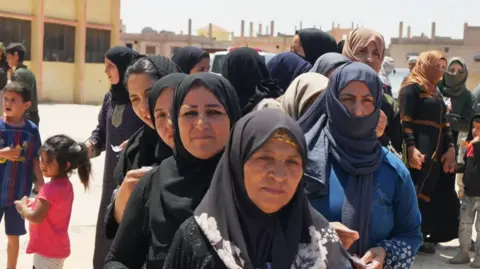
At least 128,000 people have been displaced by the violence, the UN migration agency said on Sunday. Suweida city has a severe medical supply shortage, the SOHR said.
A first humanitarian convoy from the Syrian Red Crescent has reportedly reached the city. Israel’s public broadcaster reported that Israel had sent medical aid to the Druze.
US Secretary of State Marco Rubio meanwhile has demanded that the government “hold accountable and bring to justice anyone guilty of atrocities including those in their own ranks” to preserve the possibility of a united and peaceful Syria.
In Mia’rbah, south-west of Suweida, Bedouin refugees gathered at what used to be a school. The village still bore the scars from years of civil war, with buildings lying in ruins and strewn with bullet holes.
At the aid distribution centres elderly Bedouin women collected water from a tank on the back of the truck. Most of the people there were women and children.
Asked whether she thought Bedouin and Druze could live together, one woman displaced from Suweida city said it would depend on the government in Damascus.
“They can live together if the government will take over and rule, and if the government will provide peace and security,” she said.
In the absence of government authority, she said she believed that Bedouin could not trust the Druze.
“They are traitors, without peace and security we can’t live with them,” she said.
Additional reporting by Jack Burgess
Thousands of leaflets dropped over Deir el-Balah, ordering Palestinians to move to a ‘safe zone’ Israel has repeatedly bombed.
The Israeli military has issued a new forced evacuation warning for the Palestinians in central Gaza, ordering them to move south to al-Mawasi, an area Israel has regularly attacked despite declaring it a “safe zone”.
Thousands of leaflets were dropped over Deir el-Balah on Sunday, telling displaced families living in tents in several densely populated parts of the city to leave immediately.
The Israeli military warned of imminent action against Hamas fighters in the area as it continued its deadly attacks on unarmed and starving civilians desperately looking for food, killing dozens of Palestinians on Sunday, at least 73 of them aid seekers in northern Gaza.
In a post on X, the military’s Arabic-language spokesman Avichay Adraee said residents and displaced Palestinians sheltering in the Deir el-Balah area should leave immediately.
Israel was “expanding its activities” around Deir el-Balah, including “in an area where it has not operated before”, Adraee said, telling Palestinians to “move south towards the al-Mawasi area” on the Mediterranean coast “for your safety”.

A video verified by Al Jazeera showed the Israeli army dropping vast amounts of leaflets over residential areas in Deir el-Balah, notifying Palestinians of the order.
Al Jazeera’s Hind Khoudary, reporting from Deir el-Balah, said the area targeted by Israel is densely populated and it would be “impossible” for the affected residents to leave on short notice.
“Palestinians here are refusing to leave and say they are going to stay in their houses because even the areas designated as safe by the Israeli army have been targeted,” she said.
“Palestinians say they have nowhere else to go, and there is no space because most western areas or even al-Mawasi are full of people and tents with no more extra space for expansion. They are left with zero options.”

The Israeli military issued the warning as Israel and Hamas held indirect ceasefire talks in Qatar, but international mediators said there have been no breakthroughs.
Israeli Prime Minister Benjamin Netanyahu has repeatedly stressed that expanding Israeli military operations in Gaza will pressure Hamas to negotiate, but negotiations have been stalled for months.
This month, the Israeli military said it controlled more than 65 percent of the Gaza Strip.
Most of Gaza’s population of more than two million people has been displaced at least once during the war, which is now in its 22nd month. Israel has repeatedly ordered Palestinians to leave or face attacks in large parts of the coastal enclave.
The United Nations Office for the Coordination of Humanitarian Affairs said in January that more than 80 percent of the Gaza Strip was under unrevoked Israeli evacuation threats and many of their residents were living with starvation.
A 35-day-old baby in Gaza City and a four-month-old child in Deir el-Balah died of malnutrition at Al-Aqsa Martyrs Hospital this weekend.
On Saturday, at least 116 Palestinians were killed, many of them aid seekers trying to get food from distribution sites run by the Israeli- and United States-backed Gaza Humanitarian Foundation (GHF).
At least 900 Palestinians desperate to find food have been killed at the sites since the GHF began operating them in late May as an Israeli blockade has prevented food and other necessities from the UN and other aid groups from coming into Gaza.
The genocide has prompted Pope Leo XIV to denounce the “barbarity” of the war as he urged against the “indiscriminate use of force”.
“I once again ask for an immediate end to the barbarity of the war and for a peaceful resolution to the conflict,” Leo said during a prayer meeting near Rome on Sunday.